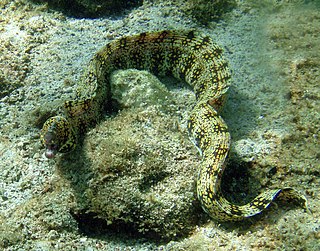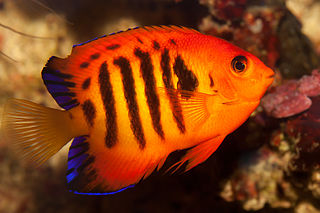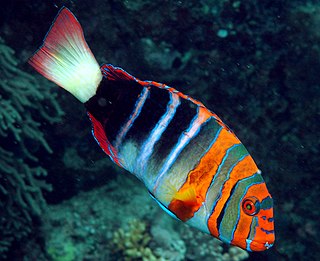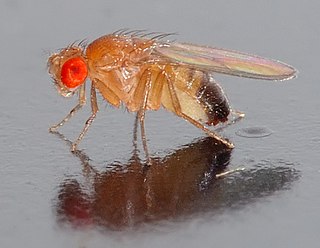
The Redtoothed triggerfish is a triggerfish of the tropical Indo-Pacific area, and the sole member of its genus. Some other common names include Blue Triggerfish, Redfang Triggerfish, Redtoothed filefish, and Niger Triggerfish.

A marine aquarium is an aquarium that keeps marine plants and animals in a contained environment. Marine aquaria are further subdivided by hobbyists into fish only (FO), fish only with live rock (FOWLR), and reef aquaria. Fish only tanks often showcase large or aggressive marine fish species and generally rely on mechanical and chemical filtration. FOWLR and reef tanks use live rock, a material composed of coral skeletons harboring beneficial nitrogen waste metabolizing bacteria, as a means of more natural biological filtration.

The cherubfish, or pygmy angelfish is a gentle omnivorous marine angelfish, with a metallic blue body and yellow to orange colouration in parts of the head only. It is native to the Caribbean and Gulf of Mexico, North to North Carolina. It has a maximum length of 8 cm. It is easily confused with the orangeback angelfish, but in the latter the orange stripe extends across the back.

The bicolor angelfish is a marine species of fish, easily recognizable by its yellow tail, yellow front half of their body, and blue rear with blue patterns above and around the eye. This angelfish is also commonly known as: Pacific rock beauty, oriole angelfish, oriole dwarf angel, blue and gold angel, and two-colored angel. The average life expectancy is 5–13 years, depending upon its location. These fish tend to grow to a maximum of 6 inches in length, making them a dwarf fish.

The snowflake moray also known as the clouded moray among many various vernacular names, is a species of marine fish of the family Muraenidae.

The flame angelfish is a marine angelfish of the family Pomacanthidae found in tropical waters of the Pacific Ocean. Other common names include flame angel, flaming angelfish, and Japanese pygmy angelfish.

The gilded triggerfish or blue-throated Triggerfish, Xanthichthys auromarginatus, is a spotted gray triggerfish. Males of the species have blue cheeks and yellow-bordered white fins. It is widely, but locally, distributed at islands in the Indo-Pacific.

Cleaner fish are fish that provide a service to other species by removing dead skin and ectoparasites. Although the animal being cleaned typically is another fish, it can also involve aquatic reptiles, mammals or octopuses. The cleaning symbiosis is an example of mutualism, an ecological interaction that benefits both parties involved. However, the cleaner fish may sometimes cheat and consume mucus or tissue, thus creating a form of parasitism. A wide variety of fish including wrasse, cichlids, catfish, pipefish, and gobies display cleaning behaviors. Similar behavior is found in other groups of animals, such as cleaner shrimps.

Balistes vetula, the queen triggerfish or old wife, is a reef dwelling triggerfish found in the Atlantic Ocean. It is occasionally caught as a gamefish, and sometimes kept in very large marine aquaria.

Genicanthus bellus is an angelfish that occasionally makes its way into the aquarium trade. Its common names are the bellus angelfish and ornate angelfish.

Apolemichthys xanthurus, the Indian yellowtail angelfish, is a species of marine angelfish of the family Pomacanthidae. Other common names include cream angelfish, smoke angelfish, or yellowtail black angelfish. The angelfish should not be confused with its relative the Yellow-ear angelfish despite similar appearances.

The six-line wrasse, Pseudocheilinus hexataenia, is a species of wrasse native to the Indian Ocean and the western Pacific Ocean. This species inhabits coral reefs at depths from 1 to 35 m. It can reach 10 cm (3.9 in) in total length. It can also be found in the aquarium trade.

The harlequin tuskfish, Choerodon fasciatus, is a species of wrasse native to the western Pacific Ocean. It occasionally makes its way into the aquarium trade.

The Lakes Aquarium is an aquarium in the village of Lakeside on the southern shore of Windermere, Cumbria, England. It is one of the docking points of Windermere Lake Cruises and also at one end of the Lakeside and Haverthwaite Railway. It is the third most visited paying tourist attraction in Cumbria

Coral reef fish are fish which live amongst or in close relation to coral reefs. Coral reefs form complex ecosystems with tremendous biodiversity. Among the myriad inhabitants, the fish stand out as colourful and interesting to watch. Hundreds of species can exist in a small area of a healthy reef, many of them hidden or well camouflaged. Reef fish have developed many ingenious specialisations adapted to survival on the reefs.

Coastal fish, also called inshore fish or neritic fish, inhabit the sea between the shoreline and the edge of the continental shelf. Since the continental shelf is usually less than 200 metres deep, it follows that pelagic coastal fish are generally epipelagic fish, inhabiting the sunlit epipelagic zone. Coastal fish can be contrasted with oceanic fish or offshore fish, which inhabit the deep seas beyond the continental shelves.

Palma Aquarium is a commercial aquarium and park that first opened in 2007 in Palma, Mallorca, Spain. The aquarium is the property of Coral World International. The aquarium is 500 m (1,600 ft) from Playa de Palma beach, and includes 55 tanks which are home to over 700 different species from the Mediterranean Sea and the Indian, Atlantic and Pacific Oceans. One tank, "Big Blue" is 8.5 m (28 ft) deep, the deepest shark tank in Europe, and it also contains the largest collection of live coral in Europe The park was awarded "Best Business Initiative in the Balearics 2007", awarded by Actualidad Económica magazine, and was awarded the "2007 Accessibility Prize" by the Consell de Mallorca.

The marine wildlife of Baa Atoll consists of marine species living in a circular archipelago in the Maldives, inside the administrative division of Baa Atoll, which is the southern part of Maalhosmadulu Atoll. Baa Atoll was named a biosphere reserve by UNESCO in 2011.
The Shreveport Aquarium is an aquarium located in Shreveport, Louisiana, United States.




















